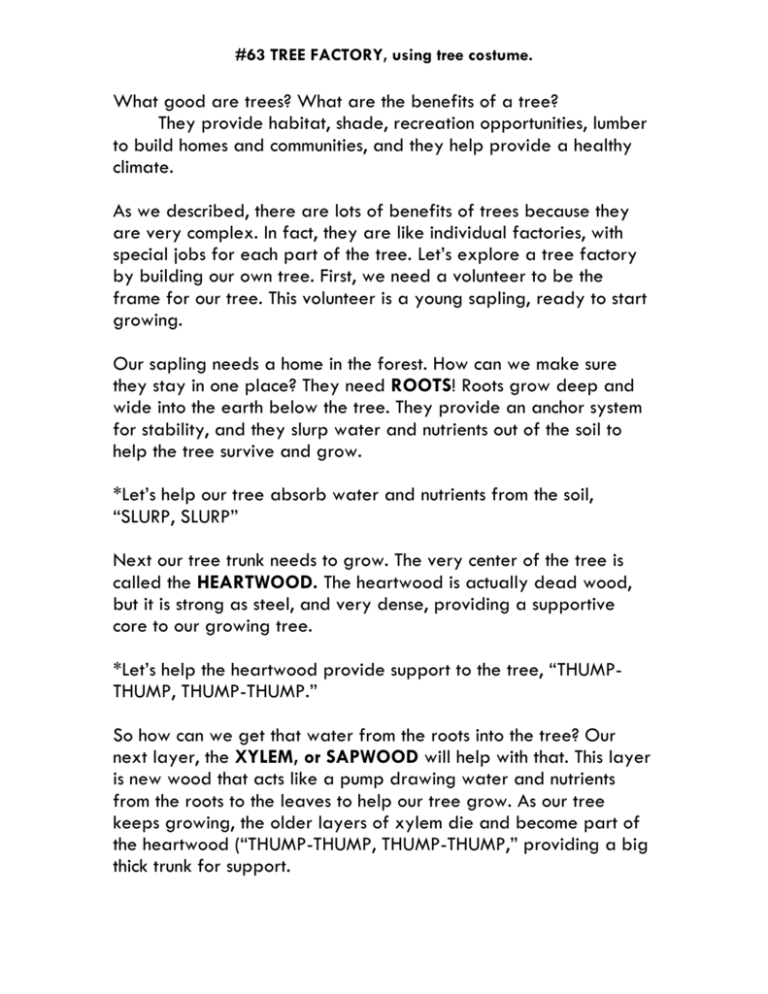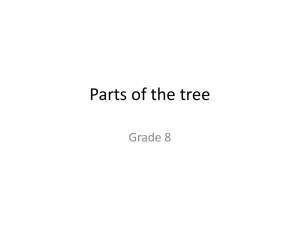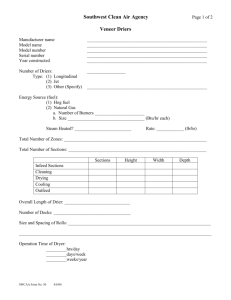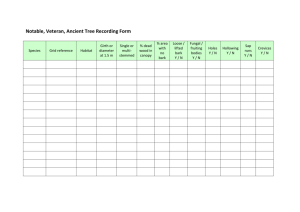TREE FACTORY, using tree costume
advertisement

#63 TREE FACTORY, using tree costume. What good are trees? What are the benefits of a tree? They provide habitat, shade, recreation opportunities, lumber to build homes and communities, and they help provide a healthy climate. As we described, there are lots of benefits of trees because they are very complex. In fact, they are like individual factories, with special jobs for each part of the tree. Let’s explore a tree factory by building our own tree. First, we need a volunteer to be the frame for our tree. This volunteer is a young sapling, ready to start growing. Our sapling needs a home in the forest. How can we make sure they stay in one place? They need ROOTS! Roots grow deep and wide into the earth below the tree. They provide an anchor system for stability, and they slurp water and nutrients out of the soil to help the tree survive and grow. *Let’s help our tree absorb water and nutrients from the soil, “SLURP, SLURP” Next our tree trunk needs to grow. The very center of the tree is called the HEARTWOOD. The heartwood is actually dead wood, but it is strong as steel, and very dense, providing a supportive core to our growing tree. *Let’s help the heartwood provide support to the tree, “THUMPTHUMP, THUMP-THUMP.” So how can we get that water from the roots into the tree? Our next layer, the XYLEM, or SAPWOOD will help with that. This layer is new wood that acts like a pump drawing water and nutrients from the roots to the leaves to help our tree grow. As our tree keeps growing, the older layers of xylem die and become part of the heartwood (“THUMP-THUMP, THUMP-THUMP,” providing a big thick trunk for support. #63 TREE FACTORY, using tree costume. *Let’s help the xylem, or sapwood, pull water from the roots (“SLURP SLURP”) to the leaves, “WHEEEE!” Our tree just keeps on growing, but how? Because of the CAMBIUM layer. This layer is only two cells thick-not very thick at all. This is the growing tissue of the tree, annually making new wood and bark. *Let’s help our tree grow, “WE MAKE NEW CELLS, WE MAKE NEW CELLS.” Now our tree needs another transport system to carry food throughout the whole tree. Our next layer is the PHLOEM or INNER BARK. The phloem or inner bark is where food flows down from the leaves to other parts of the tree. *Let’s help the phloem flush food throughout the whole tree, “WHOOSH.” The insides of our tree are very tender. This factory needs some protection. Let’s call on the BARK to defend our tree. This thick outer layer protects our tree factory from injury caused by disease, insects, wildlife, other plants, and even fire. Sometimes trees are adapted to fire, and may only partially burn, but won’t die, leaving a fire scar behind. What a great guard! *Let’s help the bark protect our tree, “BARK-BARK, BARK-BARK.” Our tree is almost complete, but where does all the energy to grow come from? The branches and crown help make our tree big and tall, and are covered in LEAVES. The leaves make food for the tree in their own tiny factories. Using chlorophyll that makes them green, the leaves capture energy from the sun and turn carbon dioxide and water into oxygen and sugar through a process called PHOTOSYNTHESIS. #63 TREE FACTORY, using tree costume. *Let’s help these busy leaves, “WE MAKE FOOD, WE MAKE FOOD.” Remember, underneath the protective bark (BARK-BARK, BARKBARK) the inner bark layer, or phloem (WHOOSH) is carrying the food from the leaves (WE MAKE FOOD, WE MAKE FOOD) throughout the whole tree. The cambium (WE MAKE NEW CELLS, WE MAKE NEW CELLS) layer is helping the tree grow, and the xylem, or sapwood (WHEE) is carrying water and nutrients from the roots (SLURP, SLURP) to the rest of the tree. All the while, the heartwood (THUMP-THUMP, THUMP-THUMP) is providing support to our growing tree. Now, is our tree complete? What about the benefits of trees we mentioned earlier? This tree is a complex factory indeed, but what else is going on around or tree? This tree also provides wildlife habitat! (“WELCOME WILDLIFE!”) -A butterfly, beetle, ant or other insect might like to eat parts of the tree or use it for a home. -A praying mantis might enjoy eating the insects living on the tree. -Birds might enjoy the insect buffet, fruits, and seeds, plus they can use the branches or cavities as a shelter or home. -Squirrels and chipmunks use the tree for food and shelter. -Coyotes use the whole forest as a home so they rely on many trees. -Bears use the whole forest as a home, plus they use the branches for shelter. So the tree not only has a factory inside, but it is part of a large community outside that benefits lots of wildlife. This place looks like a condo! Well, now it’s time for our wildlife friends to scatter into the forest and find other trees, so that we can turn our tree back into a wonderful volunteer. Say goodbye to the animals! #63 TREE FACTORY, using tree costume. We’ll first remove the branches and the crown which support the leaves (WE MAKE FOOD, WE MAKE FOOD), through a process called photosynthesis. Next we’ll remove our protective outer layer, the bark (BARK-BARK, BARK-BARK) which may be adapted to fire. Below the bark lies the phloem or inner bark (WHOOSH) where the food flows down from the leaves to the rest of the tree. Next is the growing part of the tree, the cambium layer (WE MAKE NEW CELLS, WE MAKE NEW CELLS). Behind that thin layer is the sapwood or xylem (WHEE) transporting water and nutrients from the roots to the rest of the tree. Finally, we are down to the heartwood (THUMP-THUMP, THUMP-THUMP) which is providing great support for our growing tree and wildlife condo. We’re ready to pull our tree out of the ground by removing the roots (SLURP, SLURP) which were absorbing water and nutrients from the soil. So we’re left now with a very adaptive volunteer, who deserves a round of applause!







